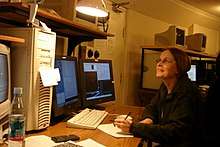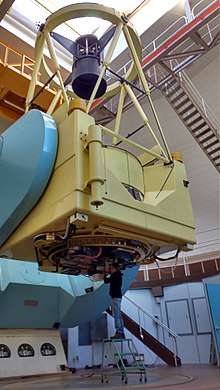Nidia Morrell
Nidia Irene Morrell (born 3 July 1953) is an Argentine astronomer who is a permanent staff member at the Las Campanas Observatory in La Serena, Chile. She was a member of the Massive Stars research group led by Virpi Niemelä and the Hubble Heritage Project. Professionally, she is known for her numerous contributions related to the astrophysics of massive stars.[1] She participates in the systematic search for variations of brightness in stellar objects, including the observation of a candidate for the Thorne–Żytkow object. She was also a member of the team that discovered the supernova ASASSN-15lh.
Nidia Morrell | |
|---|---|
 | |
| Born | Nidia Irene Morrell 3 July 1953 Mar del Plata, Argentina |
| Alma mater | National University of La Plata |
| Occupation | Astronomer |
| Employer | Las Campanas Observatory |
Career
Nidia Morrell studied astronomy at the National University of La Plata (UNLP), obtaining a licentiate in 1977 and a doctorate in 1984. She received a postdoctoral fellowship (1989–1990) sponsored by the National Scientific and Technical Research Council (CONICET) to conduct research in the United States, advised by Helmut Altrichter at the Kitt Peak National Observatory. Back in Argentina, she researched and taught at the UNLP Faculty of Astronomical and Geophysical Sciences.
She focused her work on young (mostly O-type and Wolf-Rayet) stars, in regions of star formation and binary stars of large masses, also called massive stars. That type of star quickly consumes its fuel, and ends its existence with a giant explosion: a supernova.
In La Plata, Morrell was a member of the Massive Stars research group led by Virpi Niemelä. She and Niemelä were part of the Hubble Heritage Project, which generated widely disseminated educational resources.[2] From 1996 to 2001, Morrell was a representative of Argentina and a scientific advisor to the Gemini South Observatory.[3]
For years she was one of the main users of the Jorge Sahade Telescope at the Leoncito Astronomical Complex (CASLEO). Many students, who are now astronomers and teachers, made their first observations with her at El Leoncito.[4]

In late 2002, Morrell joined the scientific team at Las Campanas Observatory and, later, the Carnegie Supernova Project (as a part-time researcher), while continuing to collaborate on massive star studies.[5] She was also a visiting professor at the National Autonomous University of Honduras and the National Autonomous University of Nicaragua.
In 2006 she settled in La Serena, Chile to continue her research.[6] Among her most outstanding observations, she participated in the discovery of ASASSN-15lh, the brightest supernova ever detected.[7][8]
Since 2008, Morrell has also participated in Chilean Observation Time Assignment Committees, contributing her knowledge about instruments and procedures for astronomical observation.[9]
In 2009, she appeared in the documentary video El silencio de las Campanas made by Ricardo Benítez, which follows the daily activity of astronomers at a high-level observatory.[10]
In 2014 she was one of the leaders in the detection of a possible hybrid star or Thorne–Żytkow object, which had been a theoretical postulate for years.[11] This discovery involved the Magellan Telescopes.[12] The chemical characteristics of this star, HV 2112, were studied using spectroscopy techniques, in which Morrell is an expert.[13]
Beliefs
Throughout her career, Morrell has motivated students of all ages to participate in scientific projects.[14] She has also joined professional initiatives to raise awareness of respecting the sky as world heritage.[15]
While nowhere in the world are resources abundant, I would say that science is going through a wonderful moment, where international collaboration is clearer and more fluid than ever (especially because of the ease of sharing information and knowledge through the Internet).[16]
She is a staunch defender of the use of free software, free knowledge, and the equality and inclusion of all human beings.[17] She has also collaborated with amateur astronomers who contribute to the search for supernovae from their homes.[18]
I live my whole life with astronomy. Maybe that is the greatest achievement, the fulfillment of a vocation, although other things in life have not gone well, being able to dedicate oneself to something that one likes so much is a valuable achievement, a privilege if you will.
Recognitions
For her passion for astronomy, her dedication to mentoring students, and the enormous amount of observational data she has gathered, the international conference Massive Stars and Supernovae was held in celebration of her 65th birthday.[19] The event took place from 5 to 9 November 2018 in Bariloche, Argentina, with the institutional support of the National University of Río Negro (UNRN), the UNLP Faculty of Astronomical and Geophysical Sciences, the Argentine Astronomy Association, the Carnegie Institution for Science, and the Municipality of Bariloche.[20]
Both for Dr. Morrell's scientific achievements and for her charisma, in the course of this meeting it was announced that the International Astronomical Union named an asteroid (Minor Planet 25906) in her honor.[21]
References
- "NASA/ADS search". Astrophysics Data System. Retrieved 10 June 2019.
- "Science Team". Hubble Heritage Project. Retrieved 10 June 2019.
- Sofía, Alejandra (27 April 2001). "Argentina y dos telescopios gemelos de 8 metros" [Argentina and Two 8-Meter Gemini Telescopes] (in Spanish). La Plata Astronomical Observatory. Retrieved 10 June 2019.
- "30 años haciendo ciencia en el Complejo Astronómico El Leoncito" [30 Years Doing Science at the El Leoncito Astronomical Complex] (in Spanish). National University of La Plata. 16 September 2016. Retrieved 10 June 2019.
- "CSP Members". Carnegie Supernova Project. Retrieved 10 June 2019.
- Bañez, Facundo (22 July 2007). "La historia de los astrónomos platenses que se van del país" [The History of La Plata Astronomers Leaving the Country]. El Día (in Spanish). Retrieved 10 June 2019.
- "La supernova más brillante de la historia" [The Brightest Supernova in History]. El Observador (in Spanish). 15 January 2016. Retrieved 10 June 2019.
- "La supernova más brillante" [The Brightest Supernova]. El Mundo (in Spanish). Madrid. Europa Press. 14 January 2016. Retrieved 10 June 2019.
- "Lista de Socios" [List of Partners] (in Spanish). SOCHIAS. Archived from the original on 13 June 2018. Retrieved 10 June 2019.
- "El silencio de Las Campanas". KosmosLogos (in Spanish). 11 May 2009. Retrieved 10 June 2019.
- Levesque, E. M.; Massey, P.; Zytkow, A. N.; Morrell, N. (September 2014). "Discovery of a Thorne-Zytkow object candidate in the Small Magellanic Cloud". Monthly Notices of the Royal Astronomical Society. Astrophysics Data System. 443: L94–L98. arXiv:1406.0001. Bibcode:2014MNRAS.443L..94L. doi:10.1093/mnrasl/slu080.
- "Astronomers discover first Thorne-Żytkow object, a bizarre type of hybrid star". University of Colorado Boulder. 4 June 2014. Retrieved 10 June 2019.
- Choi, Charles Q. (9 October 2014). "Strange 'Hybrid Star' Discovered After 40-Year Search". Space.com. Retrieved 10 June 2019.
- "En Atacama se inauguró el XIII Congreso Regional Escolar de Ciencia y Tecnología Explora CONICYT y la FERECYT" [In Atacama, the 13th Explora CONICYT and FERECYT Regional School Congress of Science and Technology Begins] (in Spanish). CONICYT. 28 October 2015. Retrieved 10 June 2019.
- "Importancia de la calidad del cielo fue el tema central de Panel Científico Técnico" [Importance of the Quality of the Sky was the Central Theme of Technical Scientific Panel] (in Spanish). University of La Serena. 24 October 2014. Retrieved 10 June 2019.
- Olivella, Patricia. "La curiosidad y el placer estético es lo que me atrae de la Astronomía" [Curiosity and Aesthetic Pleasure is What Attracts Me to Astronomy]. Cielo Sur (in Spanish). Buenos Aires. Retrieved 10 June 2019.
- "The Hipatia Manifesto". Hipatia. Retrieved 10 June 2019.
- "Meeting People". Backyard Observatory Supernova Search. Retrieved 10 June 2019.
- "Se celebra importante conferencia internacional de Astronomía en Bariloche" [An Important International Astronomy Conference is Celebrated in Bariloche] (in Spanish). Bariloche2000. 6 November 2018. Retrieved 10 June 2019.
- "Declaración N.º 2440-CM-18" (in Spanish). Bariloche Municipal Council. 18 October 2018. Retrieved 10 June 2019.
- "(25906) Morrell". Minor Planet Center. Retrieved 10 June 2019.